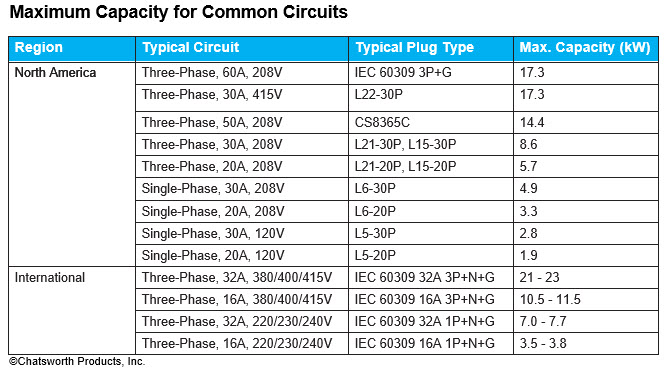One of the key considerations in selecting an intelligent power solution for high-density deployments is ensuring the power distribution unit (PDU) can handle the power demands of the equipment.
Incoming power from the utility within data centers is typically three-phase. Bringing three-phase power into the data center allows required power capacity to be delivered at a lower amperage, hence with a lower amount of losses. Organizations have a choice to bring three- or one-phase power to the cabinets. Within high-density cabinet environments, bringing three-phase power to the cabinet provides the same benefit as that of a three-phase incoming supply to the data center. The table below provides the maximum capacity that can be handled by the most common one- and three-phase circuits found in North America and international regions.

As shown in the table, for rack densities beyond 4.9 kW in North America and 7.3 kW in international regions, it makes the most sense to bring three-phase power to the cabinets. The appropriate three-phase circuit to the rack would be determined by the total rack capacity required. Generally, two power feeds are used for each cabinet to support redundancy, and each PDU should be able to support the full load of the cabinet. For example, if the cabinet has a 5 kW (5 VA) load, each PDU and supporting circuit would be sized to 10 kW (10 VA).
Three-phase power at the cabinet level not only helps minimize losses, but also simplifies load balancing across all three- phases of the incoming power into the data center. Balanced loads result in optimum utilization of the upstream electrical infrastructure by keeping neutral currents and harmonics low.
For Greenfield opportunities, data centers also have a choice of the voltage that would be supplied to the equipment in the cabinet. Most modern day IT equipment can handle voltages within a range of 100 – 250V. Choosing a higher voltage for the IT equipment leads to lower current draw and, hence, lower losses. This is why many new data centers in North America are being set up with 240/415V three-phase to the cabinets instead of the typical 208V or even 120V.
CPI’s technical staff can assist you in selecting the right power solution for your installation. For more complex projects, you can request to have one of our field engineers provide you an onsite assessment. Or, take advantage of our online resources such as the Power Selector or eConnect® Product webpage.
Ashish Moondra, Sr. Product Manager, Power, Electronics & Software